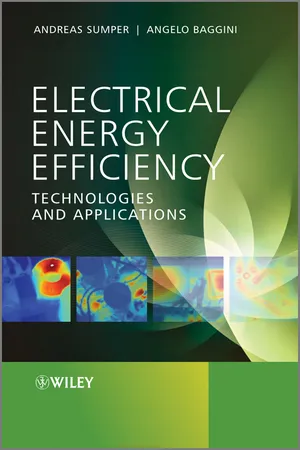
- English
- ePUB (mobile friendly)
- Available on iOS & Android
About this book
The improvement of electrical energy efficiency is fast becoming one of the most essential areas of sustainability development, backed by political initiatives to control and reduce energy demand.
Now a major topic in industry and the electrical engineering research community, engineers have started to focus on analysis, diagnosis and possible solutions. Owing to the complexity and cross-disciplinary nature of electrical energy efficiency issues, the optimal solution is often multi-faceted with a critical solutions evaluation component to ensure cost effectiveness.
This single-source reference brings a practical focus to the subject of electrical energy efficiency, providing detailed theory and practical applications to enable engineers to find solutions for electroefficiency problems. It presents power supplier as well as electricity user perspectives and promotes routine implementation of good engineering practice.
Key features include:
- a comprehensive overview of the different technologies involved in electroefficiency, outlining monitoring and control concepts and practical design techniques used in industrial applications;
- description of the current standards of electrical motors, with illustrative case studies showing how to achieve better design;
- up-to-date information on standarization, technologies, economic realities and energy efficiency indicators (the main types and international results);
- coverage on the quality and efficiency of distribution systems (the impact on distribution systems and loads, and the calculation of power losses in distribution lines and in power transformers).
With invaluable practical advice, this book is suited to practicing electrical engineers, design engineers, installation designers, M&E designers, and economic engineers. It equips maintenance and energy managers, planners, and infrastructure managers with the necessary knowledge to properly evaluate the wealth of electrical energy efficiency solutions for large investments. This reference also provides interesting reading material for energy researchers, policy makers, consultants, postgraduate engineering students and final year undergraduate engineering students.
Frequently asked questions
- Essential is ideal for learners and professionals who enjoy exploring a wide range of subjects. Access the Essential Library with 800,000+ trusted titles and best-sellers across business, personal growth, and the humanities. Includes unlimited reading time and Standard Read Aloud voice.
- Complete: Perfect for advanced learners and researchers needing full, unrestricted access. Unlock 1.4M+ books across hundreds of subjects, including academic and specialized titles. The Complete Plan also includes advanced features like Premium Read Aloud and Research Assistant.
Please note we cannot support devices running on iOS 13 and Android 7 or earlier. Learn more about using the app.
Information
- Institutions and programmes
- Institutions: agencies (national, regional and local), Ministry department
- National programmes of energy efficiency with quantitative targets and laws
- Regulatory measures
- Minimum efficiency standards and labels for electrical appliances (e.g. refrigerators, washing machines, AC, lamps, water heaters, motors), cars and buildings (new and existing)
- Other regulations for designated consumers: mandatory energy managers, mandatory energy consumption reporting, mandatory energy saving and mandatory maintenance
- Obligation of energy savings for energy companies at consumers’ premises
- Financial and fiscal measures
- Subsidies for audits by sector (industry, commercial, public, households, low income households transport)
- Subsidies or soft loans (i.e. loans with subsidised interest rates) for energy efficiency investment and equipment by sector
- Fiscal measures
- Tax credit
- Accelerate depreciation
- Tax reduction for efficiency investment, by type of tax (import, VAT, purchase, annual car registration) and by type of equipment (appliances, cars, lamps)
- Cross-cutting measures
- Innovative communication tools
- Voluntary agreements.
| Buildings |
|
| Industry |
|
| Transport |
|
| Buildings |
|
| Industry |
|
| Transport |
|
Table of contents
- Cover
- Title Page
- Copyright
- List of Contributors
- Preface
- Foreword
- 1: Overview of Standardization of Energy Efficiency
- 2: Cables and Lines
- 3: Power Transformers
- 4: Building Automation, Control and Management Systems
- 5: Power Quality Phenomena and Indicators
- 6: On Site Generation and Microgrids
- 7: Electric Motors
- 8: Lighting
- 9: Electrical Drives and Power Electronics
- 10: Industrial Heating Processes
- 11: Heat, Ventilation and Air Conditioning (HVAC)
- 12: Data Centres
- 13: Reactive Power Compensation
- Index